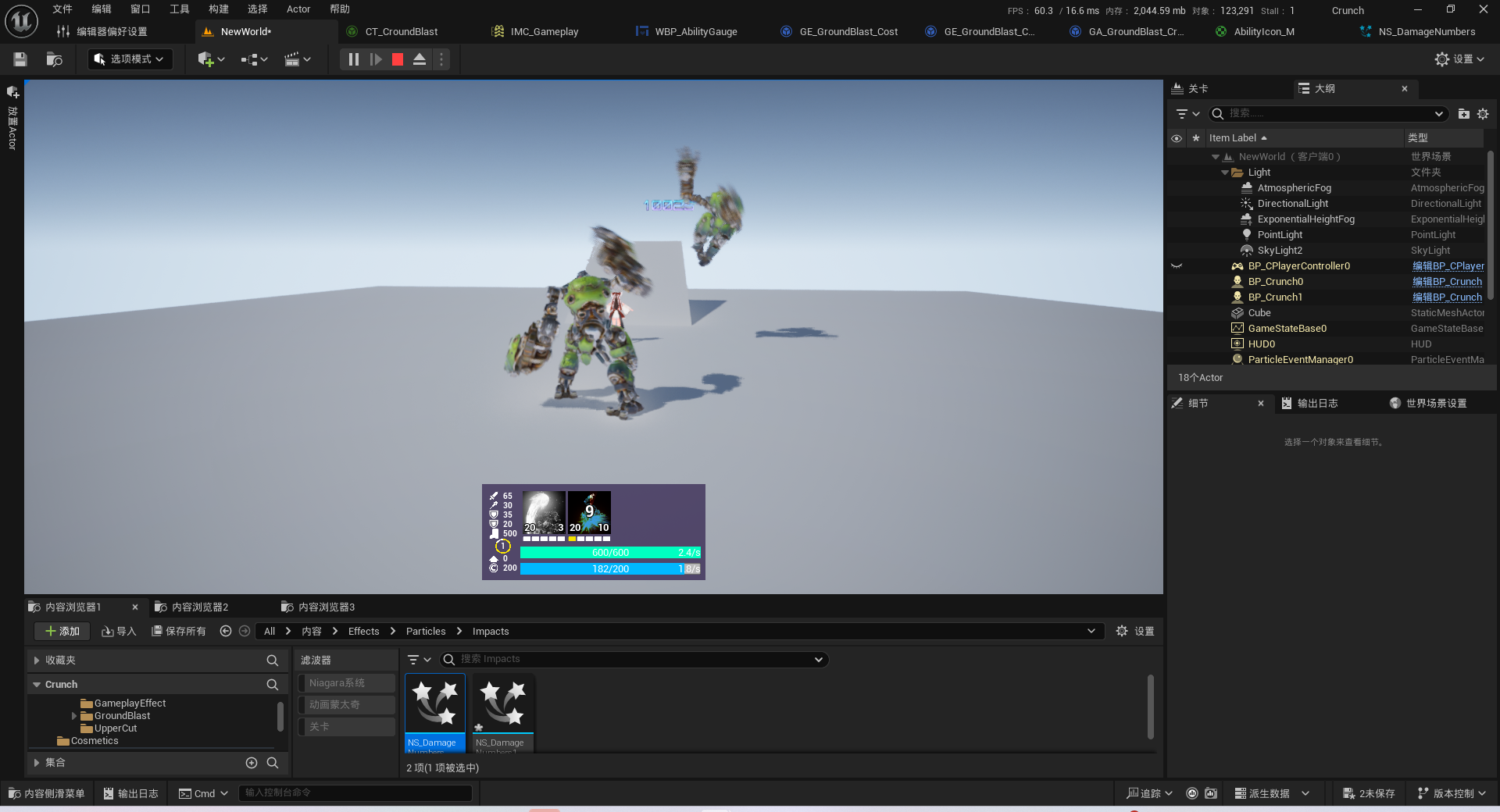文章目录
前言
重写技能基类的判断是否可以释放技能的函数CanActivateAbility,因为基本技能和被动的初始等级是1,技能数组里的需要通过学习才能释放。
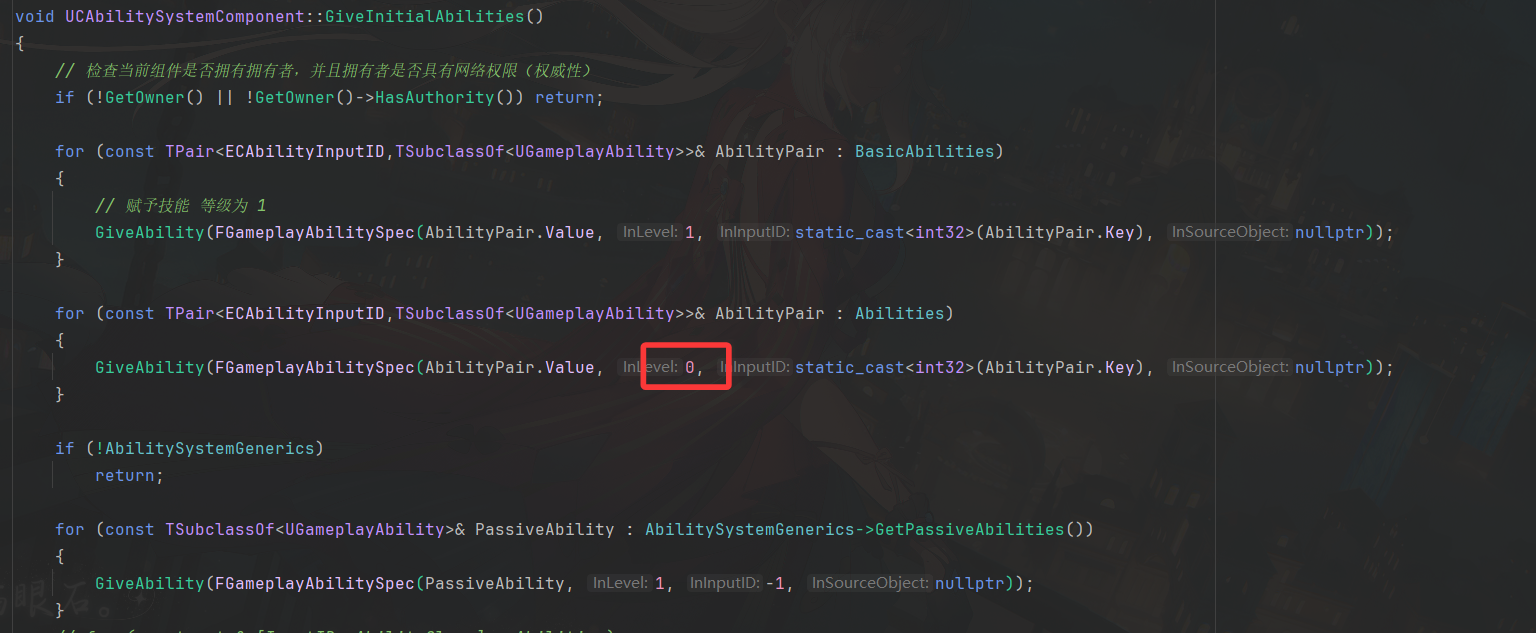
virtual bool CanActivateAbility(const FGameplayAbilitySpecHandle Handle, const FGameplayAbilityActorInfo* ActorInfo, const FGameplayTagContainer* SourceTags = nullptr, const FGameplayTagContainer* TargetTags = nullptr, OUT FGameplayTagContainer* OptionalRelevantTags = nullptr) const override;
获取技能的等级如果技能等级小于等于0返回false,不能释放
bool UCGameplayAbility::CanActivateAbility(const FGameplayAbilitySpecHandle Handle,
const FGameplayAbilityActorInfo* ActorInfo, const FGameplayTagContainer* SourceTags,
const FGameplayTagContainer* TargetTags, FGameplayTagContainer* OptionalRelevantTags) const
{
FGameplayAbilitySpec* AbilitySpec = ActorInfo->AbilitySystemComponent->FindAbilitySpecFromHandle(Handle);
if (AbilitySpec && AbilitySpec->Level <= 0)
{
return false;
}
return Super::CanActivateAbility(Handle, ActorInfo, SourceTags, TargetTags, OptionalRelevantTags);
}
技能的升级
修改一下按键的输入
在CGameplayAbilityTypes的ECAbilityInputID 添加一些新的输入
UENUM(BlueprintType)
enum class ECAbilityInputID : uint8
{
None UMETA(DisplayName="None"),
BasicAttack UMETA(DisplayName="基础攻击"),
Aim UMETA(DisplayName="瞄准"),
AbilityOne UMETA(DisplayName="一技能"),
AbilityTwo UMETA(DisplayName="二技能"),
AbilityThree UMETA(DisplayName="三技能"),
AbilityFour UMETA(DisplayName="四技能"),
AbilityFive UMETA(DisplayName="五技能"),
AbilitySix UMETA(DisplayName="六技能"),
AbilityQ UMETA(DisplayName="Q技能"),
AbilityE UMETA(DisplayName="E技能"),
AbilityF UMETA(DisplayName="F技能"),
AbilityR UMETA(DisplayName="R技能"),
Confirm UMETA(DisplayName="确认"),
Cancel UMETA(DisplayName="取消")
};

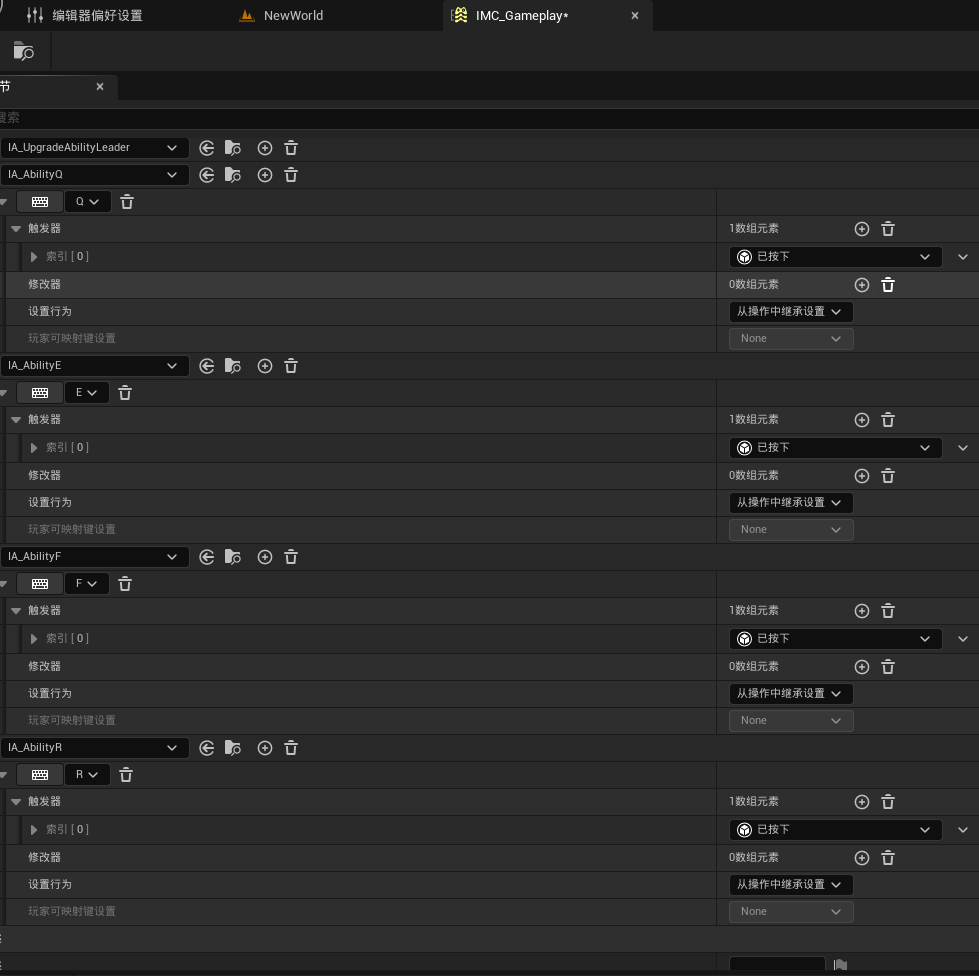
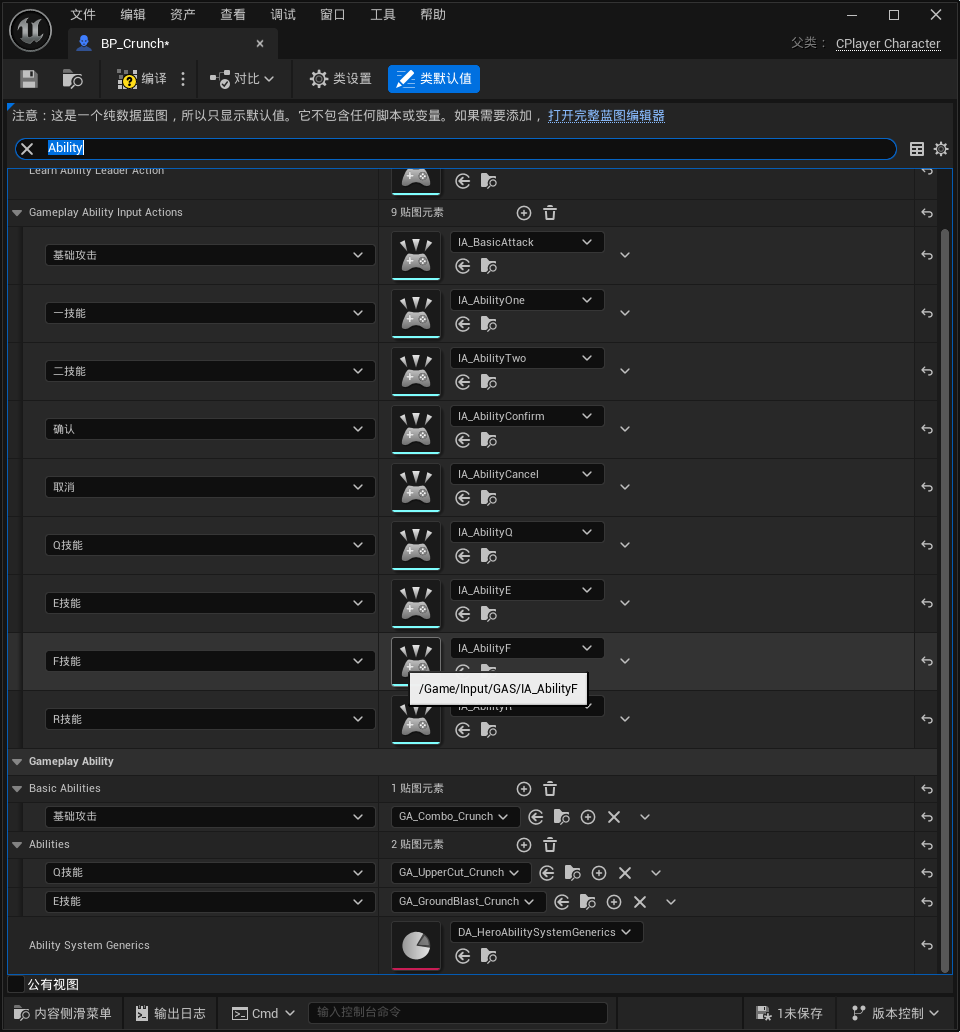
判断是否满级
技能的升级之前需要先判断技能是否满级,在CAbilitySystemStatics中添加一个函数判断是否为满级
// 判断技能是否达到最大等级
static bool IsAbilityAtMaxLevel(const FGameplayAbilitySpec& Spec, const float PlayLevel);
bool UCAbilitySystemStatics::IsAbilityAtMaxLevel(const FGameplayAbilitySpec& Spec, const float PlayLevel)
{
float MaxLevel;
// 如果是大招进来了
if (Spec.InputID == static_cast<int32>(ECAbilityInputID::AbilityR))
{
// 6~10 : 1
// 11~15 : 2
// 16~18 : 3
MaxLevel = PlayLevel >= 16 ? 3 :
PlayLevel >= 11 ? 2 :
PlayLevel >= 6 ? 1 :
0;
}else
{
// Q、E、F的小技能
/*
* 1 ~ 2 :1
* 3 ~ 4 :2
* 5 ~ 6 :3
* 7 ~ 8 :4
* 9 ~18:5
*/
MaxLevel = PlayLevel >= 9 ? 5 :
PlayLevel >= 7 ? 4 :
PlayLevel >= 5 ? 3 :
PlayLevel >= 3 ? 2 :
1;
}
// Spec.InputID
return Spec.Level >= MaxLevel;
}
在ASC中升级技能
/**
* 服务器端处理能力升级请求
* 通过指定的ECAbilityInputID参数升级对应能力
* 包含可靠的网络验证机制
* @param InputID - 要升级的能力输入ID
*/
UFUNCTION(Server, Reliable, WithValidation)
void Server_UpgradeAbilityWithID(ECAbilityInputID InputID);
/**
* 客户端能力等级更新同步
* 当能力等级发生变化时触发网络同步
* 通过GameplayAbilitySpecHandle定位具体能力实例
* @param Handle - 能力实例句柄
* @param NewLevel - 新的能力等级数值
*/
UFUNCTION(Client, Reliable)
void Client_AbilitySpecLevelUpdated(FGameplayAbilitySpecHandle Handle, int NewLevel);
在ASC中实现技能在服务器中升级,并响应客户端的同步更新
void void UCAbilitySystemComponent::Server_UpgradeAbilityWithID_Implementation(ECAbilityInputID InputID)
{
// 获取可用升级点数
bool bFound = false;
float UpgradePoint = GetGameplayAttributeValue(UCHeroAttributeSet::GetUpgradePointAttribute(), bFound);
// 检查可用升级点数是否大于0
if (!bFound && UpgradePoint <= 0) return;
// 获取玩家等级
float CurrentLevel = GetGameplayAttributeValue(UCHeroAttributeSet::GetLevelAttribute(), bFound);
if (!bFound) return;
// 获取对应输入ID的技能
FGameplayAbilitySpec* AbilitySpec = FindAbilitySpecFromInputID(static_cast<int32>(InputID));
// 检查是否有该技能以及等级是否满级
if (!AbilitySpec || UCAbilitySystemStatics::IsAbilityAtMaxLevel(*AbilitySpec,CurrentLevel))
{
return;
}
UE_LOG(LogTemp, Warning, TEXT("技能升级成功%d"),InputID)
// 消耗一个技能点升级技能
SetNumericAttributeBase(UCHeroAttributeSet::GetUpgradePointAttribute(), UpgradePoint - 1);
AbilitySpec->Level += 1;
// 标记 FGameplayAbilitySpec 状态已改变,通知 GAS 需要将其复制到客户端
// (直接修改AbilitySpec成员后必须调用此函数)
MarkAbilitySpecDirty(*AbilitySpec);
// 通知客户端更新技能等级
Client_AbilitySpecLevelUpdated(AbilitySpec->Handle, AbilitySpec->Level);
}
bool UCAbilitySystemComponent::Server_UpgradeAbilityWithID_Validate(ECAbilityInputID InputID)
{
return true;
}
void UCAbilitySystemComponent::Client_AbilitySpecLevelUpdated_Implementation(FGameplayAbilitySpecHandle Handle,
int NewLevel)
{
// 通过句柄查找本地技能实例
if (FGameplayAbilitySpec* const Spec = FindAbilitySpecFromHandle(Handle))
{
// 更新客户端技能等级
Spec->Level = NewLevel;
// 广播变更通知,刷新等客户端响应
AbilitySpecDirtiedCallbacks.Broadcast(*Spec);
}
}
由角色的输入调用ASC的升级功能
到角色CCharacter中调用技能的升级,
protected:
void UpgradeAbilityWithInputID(ECAbilityInputID InputID);
void ACCharacter::UpgradeAbilityWithInputID(ECAbilityInputID InputID)
{
if (CAbilitySystemComponent)
{
CAbilitySystemComponent->Server_UpgradeAbilityWithID(InputID);
}
}
再到玩家角色中通过输入来调用该升级函数,添加一个新的输入用来判断Ctrl按键是否按下,用Ctrl+技能输入ID来进行升级
// 技能升级触发键
UPROPERTY(EditDefaultsOnly, Category = "Input")
TObjectPtr<UInputAction> LearnAbilityLeaderAction;
// 技能升级触发按下
void LearnAbilityLeaderDown(const FInputActionValue& InputActionValue);
// 技能升级触发抬起
void LearnAbilityLeaderUp(const FInputActionValue& InputActionValue);
// 是否按下技能升级键
bool bIsLearnAbilityLeaderDown = false;
在这里我只想要我的设定几个按键的技能可以升级
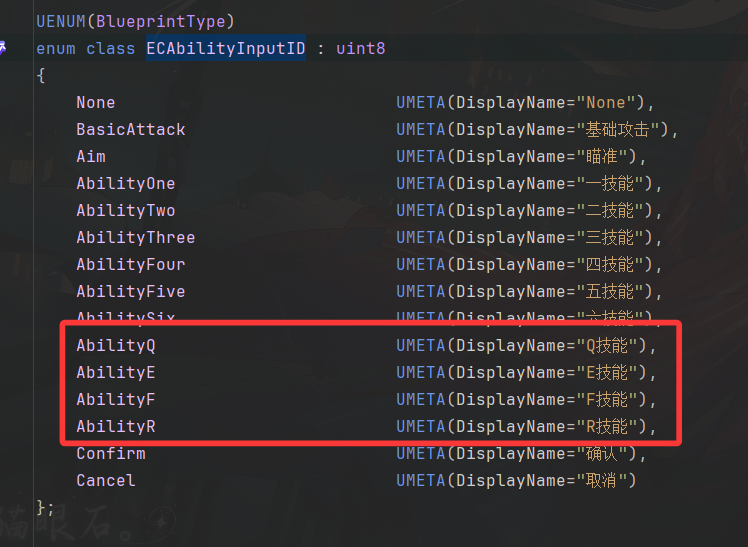
void ACPlayerCharacter::SetupPlayerInputComponent(UInputComponent* PlayerInputComponent)
{
Super::SetupPlayerInputComponent(PlayerInputComponent);
if (UEnhancedInputComponent* EnhancedInputComponent = CastChecked<UEnhancedInputComponent>(PlayerInputComponent))
{
// 绑定跳、看、走
EnhancedInputComponent->BindAction(JumpInputAction, ETriggerEvent::Triggered, this, &ACPlayerCharacter::Jump);
EnhancedInputComponent->BindAction(LookInputAction, ETriggerEvent::Triggered, this, &ACPlayerCharacter::HandleLookInput);
EnhancedInputComponent->BindAction(MoveInputAction, ETriggerEvent::Triggered, this, &ACPlayerCharacter::HandleMoveInput);
// 按下
EnhancedInputComponent->BindAction(LearnAbilityLeaderAction, ETriggerEvent::Started, this, &ACPlayerCharacter::LearnAbilityLeaderDown);
// 抬起
EnhancedInputComponent->BindAction(LearnAbilityLeaderAction, ETriggerEvent::Completed, this, &ACPlayerCharacter::LearnAbilityLeaderUp);
// 绑定技能输入
for (const TPair<ECAbilityInputID, TObjectPtr<UInputAction>>& InputActionPair : GameplayAbilityInputActions)
{
EnhancedInputComponent->BindAction(InputActionPair.Value, ETriggerEvent::Triggered, this, &ACPlayerCharacter::HandleAbilityInput, InputActionPair.Key);
}
}
}
void ACPlayerCharacter::HandleAbilityInput(const FInputActionValue& InputActionValue, ECAbilityInputID InputID)
{
bool bPressed = InputActionValue.Get<bool>();
// 技能升级
if (bPressed && bIsLearnAbilityLeaderDown)
{
// 只会升级Q、E、F、R技能
if (InputID >= ECAbilityInputID::AbilityQ && InputID <= ECAbilityInputID::AbilityR)
{
UpgradeAbilityWithInputID(InputID);
}
return;
}
// 按下
if (bPressed)
{
GetAbilitySystemComponent()->AbilityLocalInputPressed(static_cast<int32>(InputID));
}
else
{
GetAbilitySystemComponent()->AbilityLocalInputReleased(static_cast<int32>(InputID));
}
// 按下的是普攻键
if (InputID == ECAbilityInputID::BasicAttack)
{
FGameplayTag BasicAttackTag = bPressed ? TGameplayTags::Ability_BasicAttack_Pressed : TGameplayTags::Ability_BasicAttack_Released;
// 1. 本地直接广播(触发客户端即时反馈)
// 2. 服务器RPC广播(确保权威状态同步)
UAbilitySystemBlueprintLibrary::SendGameplayEventToActor(this, BasicAttackTag, FGameplayEventData());
Server_SendGameplayEventToSelf(BasicAttackTag, FGameplayEventData());
}
}
void ACPlayerCharacter::LearnAbilityLeaderDown(const FInputActionValue& InputActionValue)
{
bIsLearnAbilityLeaderDown = true;
}
void ACPlayerCharacter::LearnAbilityLeaderUp(const FInputActionValue& InputActionValue)
{
bIsLearnAbilityLeaderDown = false;
}
创建一个输入
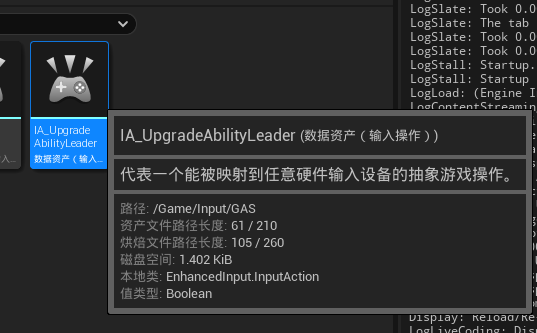

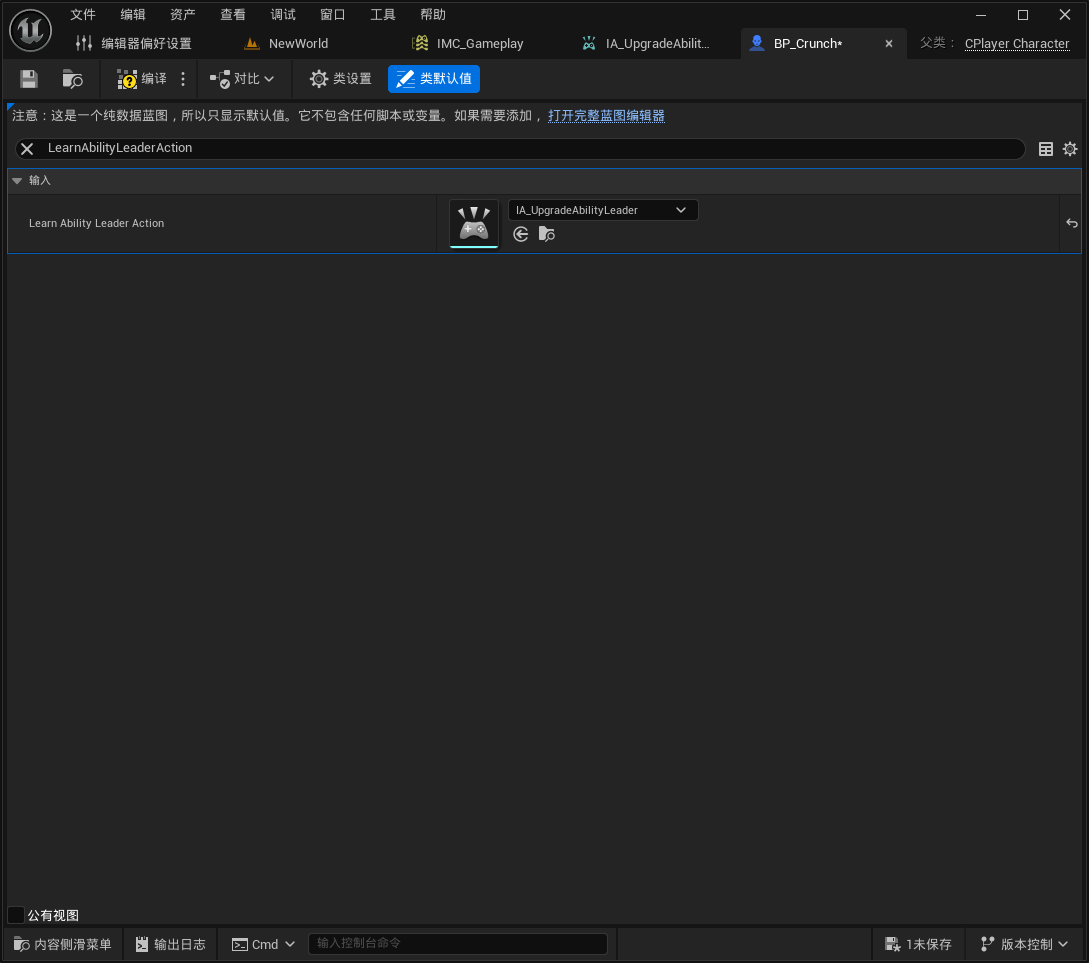
技能图标的优化
技能升级材质,可升级技能图标的闪烁
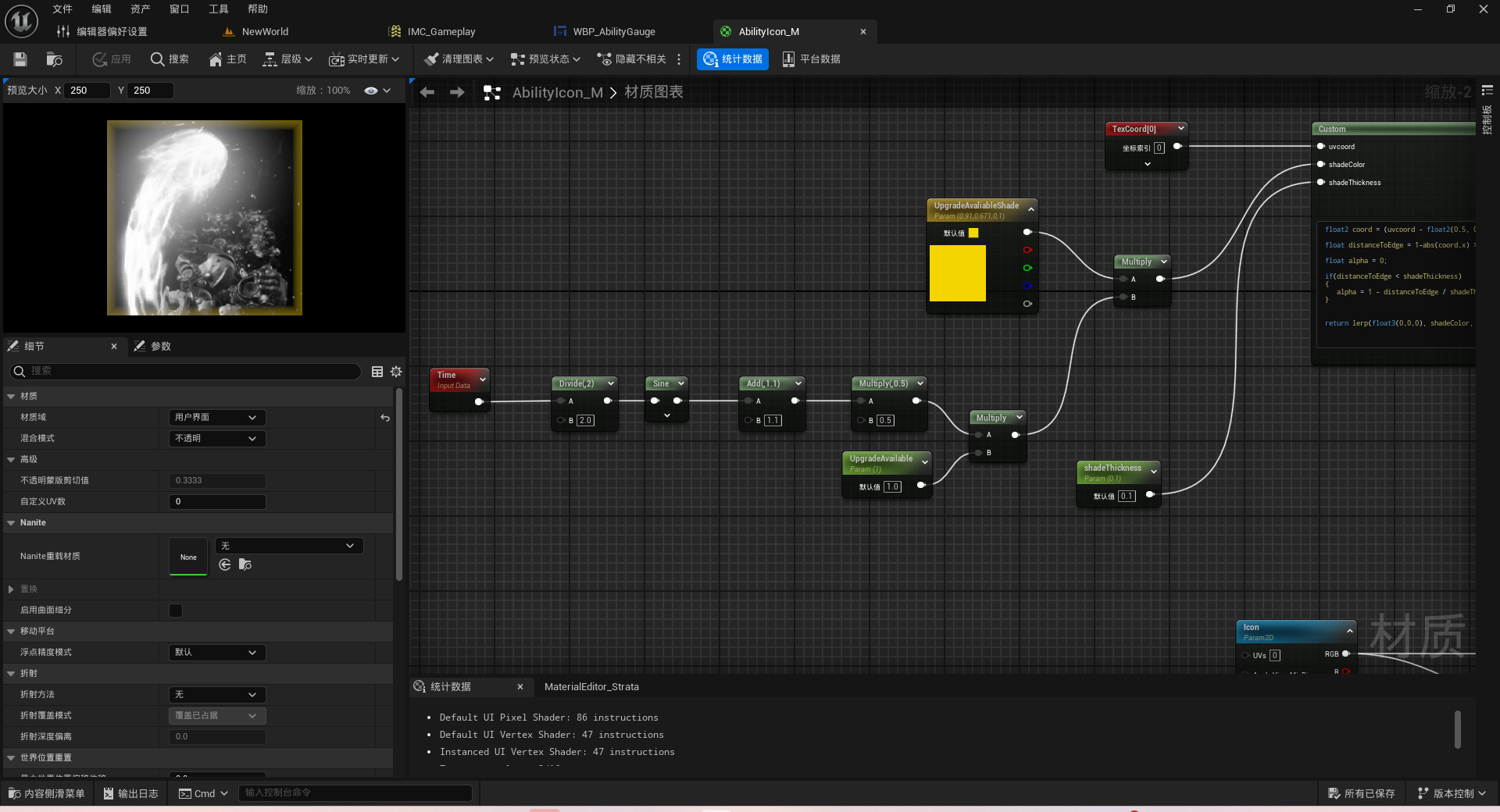
float2 coord = (uvcoord - float2(0.5, 0.5)) * 2;
float distanceToEdge = 1-abs(coord.x) > 1-abs(coord.y) ? 1 - abs(coord.y) : 1-abs(coord.x);
float alpha = 0;
if(distanceToEdge < shadeThickness)
{
alpha = 1 - distanceToEdge / shadeThickness;
}
return lerp(float3(0,0,0), shadeColor, alpha);
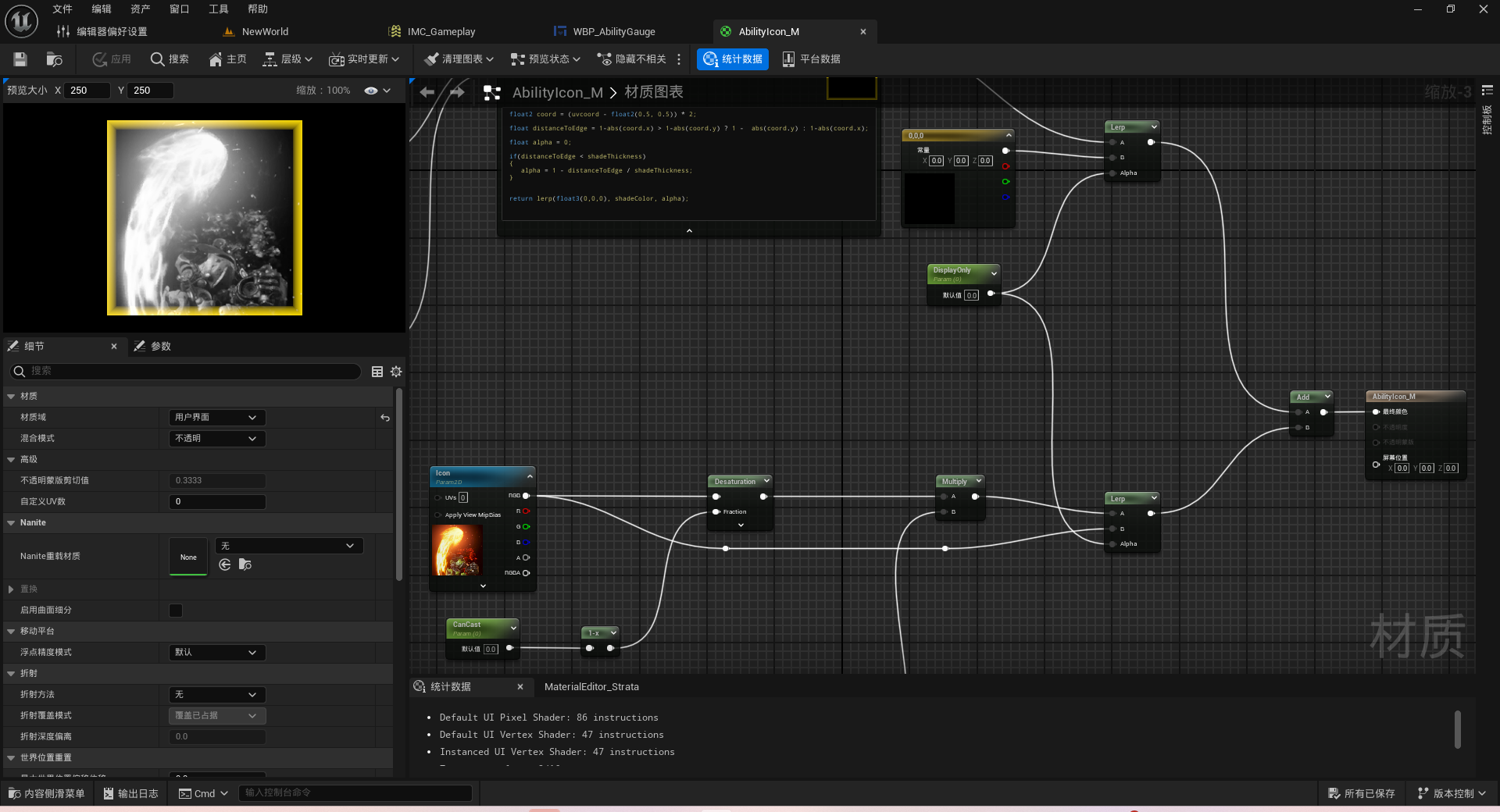

UTiling用于设置技能的最大等级(原本的基础上拓展了一下)

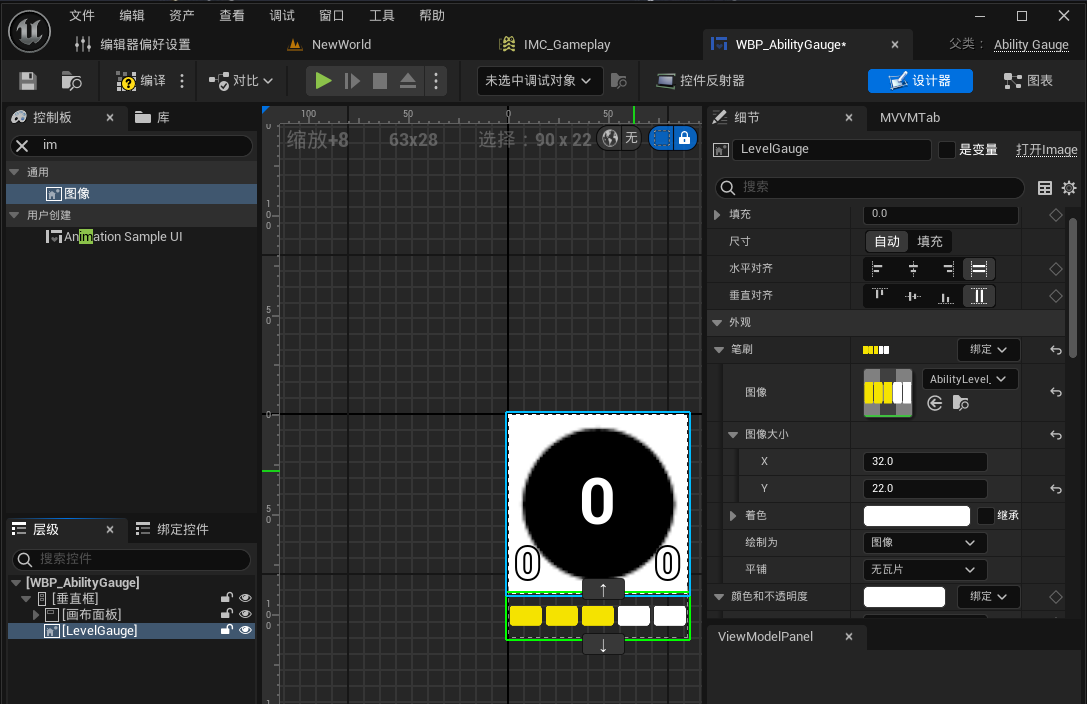
对技能图标AbilityGauge添加代码
// 技能等级材质参数名
UPROPERTY(EditDefaultsOnly, Category = "Visual")
FName AbilityLevelParamName = "Level";
// 能否释放技能材质参数名
UPROPERTY(EditDefaultsOnly, Category = "Visual")
FName CanCastAbilityParamName = "CanCast";
// 是否有可用升级点材质参数名
UPROPERTY(EditDefaultsOnly, Category = "Visual")
FName UpgradePointAvailableParamName = "UpgradeAvailable";
// 最大升级的材质参数名
UPROPERTY(EditDefaultsOnly, Category = "Visual")
FName MaxLevelParamName = "UTiling";
// 技能等级进度条控件
UPROPERTY(meta=(BindWidget))
TObjectPtr<UImage> LevelGauge;
// 技能所属的能力组件
TObjectPtr<const UAbilitySystemComponent> OwnerAbilitySystemComponent;
// 缓存的技能句柄
FGameplayAbilitySpecHandle CachedAbilitySpecHandle;
// 获取技能Spec
const FGameplayAbilitySpec* GetAbilitySpec();
// 技能是否学习
bool bIsAbilityLearned = false;
// 技能更新回调
void AbilitySpecUpdated(const FGameplayAbilitySpec& AbilitySpec);
// 刷新技能能否释放技能状态
void UpdateCanCast();
// 技能升级点变化回调
void UpgradePointUpdated(const FOnAttributeChangeData& Data);
此处的监听是在,ASC的客户端更新处广播的
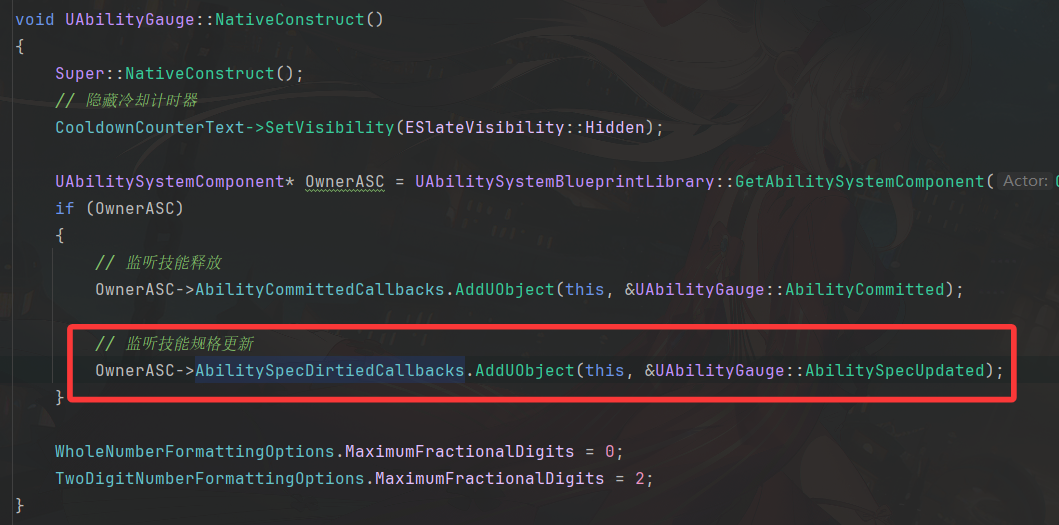

void UAbilityGauge::NativeConstruct()
{
Super::NativeConstruct();
// 隐藏冷却计时器
CooldownCounterText->SetVisibility(ESlateVisibility::Hidden);
UAbilitySystemComponent* OwnerASC = UAbilitySystemBlueprintLibrary::GetAbilitySystemComponent(GetOwningPlayerPawn());
if (OwnerASC)
{
// 监听技能释放
OwnerASC->AbilityCommittedCallbacks.AddUObject(this, &UAbilityGauge::AbilityCommitted);
// 监听技能规格更新
OwnerASC->AbilitySpecDirtiedCallbacks.AddUObject(this, &UAbilityGauge::AbilitySpecUpdated);
// 绑定升级点属性变化事件 - 当玩家获得/消耗升级点时触发
OwnerASC->GetGameplayAttributeValueChangeDelegate(UCHeroAttributeSet::GetUpgradePointAttribute())
.AddUObject(this, &UAbilityGauge::UpgradePointUpdated);
// 初始化升级点显示(获取当前值并刷新UI)
bool bFound = false;
float UpgradePoint = OwnerASC->GetGameplayAttributeValue(UCHeroAttributeSet::GetUpgradePointAttribute(), bFound);
if (bFound)
{
// 创建属性变化数据结构(模拟属性变化事件)
FOnAttributeChangeData ChangeData;
ChangeData.NewValue = UpgradePoint;
// 手动调用升级点更新函数以刷新UI
UpgradePointUpdated(ChangeData);
}
// 保存能力系统组件引用供后续使用
OwnerAbilitySystemComponent = OwnerASC;
}
WholeNumberFormattingOptions.MaximumFractionalDigits = 0;
TwoDigitNumberFormattingOptions.MaximumFractionalDigits = 2;
}
void UAbilityGauge::NativeOnListItemObjectSet(UObject* ListItemObject)
{
IUserObjectListEntry::NativeOnListItemObjectSet(ListItemObject);
AbilityCDO = Cast<UGameplayAbility>(ListItemObject);
// 获取冷却和消耗
float CoolDownDuration = UCAbilitySystemStatics::GetStaticCooldownDurationForAbility(AbilityCDO);
float Cost = UCAbilitySystemStatics::GetStaticCostForAbility(AbilityCDO);
// 设置冷却和消耗
CooldownDurationText->SetText(FText::AsNumber(CoolDownDuration));
CostText->SetText(FText::AsNumber(Cost));
LevelGauge->GetDynamicMaterial()->SetScalarParameterValue(AbilityLevelParamName, 0);
}
// 这里我添加了技能等级的初始化
void UAbilityGauge::NativeOnListItemObjectSet(UObject* ListItemObject)
{
IUserObjectListEntry::NativeOnListItemObjectSet(ListItemObject);
AbilityCDO = Cast<UGameplayAbility>(ListItemObject);
// 获取冷却和消耗
float CoolDownDuration = UCAbilitySystemStatics::GetStaticCooldownDurationForAbility(AbilityCDO);
float Cost = UCAbilitySystemStatics::GetStaticCostForAbility(AbilityCDO);
// 设置冷却和消耗
CooldownDurationText->SetText(FText::AsNumber(CoolDownDuration));
CostText->SetText(FText::AsNumber(Cost));
// 初始化技能等级
LevelGauge->GetDynamicMaterial()->SetScalarParameterValue(AbilityLevelParamName, 0);
// 初始化技能的最大等级
// 获取当前技能规格
const FGameplayAbilitySpec* AbilitySpec = GetAbilitySpec();
if (AbilitySpec)
{
float MaxLevel = AbilitySpec->InputID == static_cast<int32>(ECAbilityInputID::AbilityR) ? 3 : 5;
LevelGauge->GetDynamicMaterial()->SetScalarParameterValue(MaxLevelParamName, MaxLevel);
}
}
const FGameplayAbilitySpec* UAbilityGauge::GetAbilitySpec()
{
// 技能组件和技能对象不存在
if (!OwnerAbilitySystemComponent || !AbilityCDO) return nullptr;
// 技能缓存句柄无效,重新查找
if (!CachedAbilitySpecHandle.IsValid())
{
// 根据技能类查找规格
FGameplayAbilitySpec* FoundAbilitySpec = OwnerAbilitySystemComponent->FindAbilitySpecFromClass(AbilityCDO->GetClass());
// 缓存找到的规格句柄(Handle)
CachedAbilitySpecHandle = FoundAbilitySpec->Handle;
return FoundAbilitySpec;
}
// 技能缓存句柄有效,返回缓存的规格
return OwnerAbilitySystemComponent->FindAbilitySpecFromHandle(CachedAbilitySpecHandle);
}
void UAbilityGauge::AbilitySpecUpdated(const FGameplayAbilitySpec& AbilitySpec)
{
// 检测技能是否为该图标技能
if (AbilitySpec.Ability != AbilityCDO) return;
// 更新学习状态
bIsAbilityLearned = AbilitySpec.Level > 0;
// 更新显示的技能等级
LevelGauge->GetDynamicMaterial()->SetScalarParameterValue(AbilityLevelParamName, AbilitySpec.Level);
// 刷新技能能否释放的状态
UpdateCanCast();
}
void UAbilityGauge::UpdateCanCast()
{
Icon->GetDynamicMaterial()->SetScalarParameterValue(CanCastAbilityParamName, bIsAbilityLearned ? 1 : 0);
}
void UAbilityGauge::UpgradePointUpdated(const FOnAttributeChangeData& Data)
{
// 检查是否有可用升级点
bool HasUpgradePoint = Data.NewValue > 0;
// 获取当前技能规格
const FGameplayAbilitySpec* AbilitySpec = GetAbilitySpec();
if (AbilitySpec && OwnerAbilitySystemComponent)
{
// 获取玩家等级
bool bFound;
float CurrentLevel = OwnerAbilitySystemComponent->GetGameplayAttributeValue(UCHeroAttributeSet::GetLevelAttribute(), bFound);
if (bFound)
{
// 如果技能已达目前的最大等级,不显示升级提示
if (UCAbilitySystemStatics::IsAbilityAtMaxLevel(*AbilitySpec, CurrentLevel))
{
Icon->GetDynamicMaterial()->SetScalarParameterValue(UpgradePointAvailableParamName, 0);
return;
}
}
}
// 更新UI材质显示(1=可升级,0=不可升级)
Icon->GetDynamicMaterial()->SetScalarParameterValue(UpgradePointAvailableParamName, HasUpgradePoint ? 1 : 0);
}
两个技能都可以升级
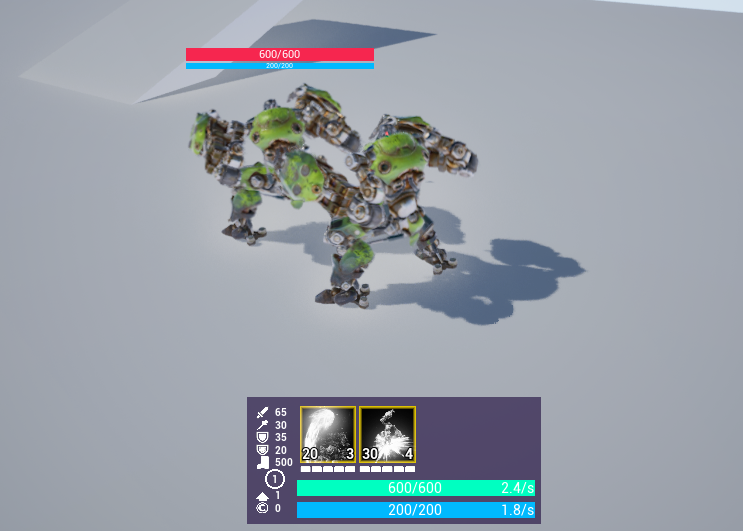
2级小技能只能升到一级,已经升级的不会闪烁
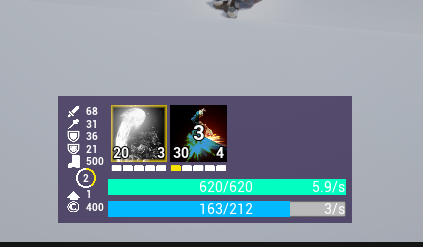
刷新技能升级后的蓝耗和CD,以及蓝不够时技能进入灰色状态
到CAbilitySystemStatics中添加一些函数
// 检查当前是否可以支付技能消耗(法力等)
// @param AbilitySpec - 要检查的技能规格数据
// @param ASC - 所属的能力系统组件
// @return 如果资源足够支付消耗返回true,否则false
static bool CheckAbilityCost(const FGameplayAbilitySpec& AbilitySpec, const UAbilitySystemComponent& ASC);
// 检查技能消耗(静态)
static bool CheckAbilityCostStatic(const UGameplayAbility* AbilityCDO, const UAbilitySystemComponent& ASC);
// 获取技能的当前法力消耗值
// @param AbilityCDO - 技能的默认对象(Class Default Object)
// @param ASC - 所属的能力系统组件(用于获取属性修饰符)
// @param AbilityLevel - 当前技能等级
// @return 计算后的实际法力消耗值
static float GetManaCostFor(const UGameplayAbility* AbilityCDO, const UAbilitySystemComponent& ASC, int AbilityLevel);
// 获取技能的当前冷却时间
// @param AbilityCDO - 技能的默认对象
// @param ASC - 所属的能力系统组件(用于获取冷却修饰符)
// @param AbilityLevel - 当前技能等级
// @return 计算后的实际冷却时间(秒)
static float GetCooldownDurationFor(const UGameplayAbility* AbilityCDO, const UAbilitySystemComponent& ASC, int AbilityLevel);
// 获取技能的剩余冷却时间
// @param AbilityCDO - 技能的默认对象
// @param ASC - 所属的能力系统组件
// @return 剩余的冷却时间(秒),如果不在冷却中返回0
static float GetCooldownRemainingFor(const UGameplayAbility* AbilityCDO, const UAbilitySystemComponent& ASC);
bool UCAbilitySystemStatics::CheckAbilityCost(const FGameplayAbilitySpec& AbilitySpec,
const UAbilitySystemComponent& ASC)
{
// 获取技能
const UGameplayAbility* AbilityCDO = AbilitySpec.Ability;
if (AbilityCDO)
{
// 调用技能的检查消耗方法
return AbilityCDO->CheckCost(AbilitySpec.Handle, ASC.AbilityActorInfo.Get());
}
// 技能无效
return false;
}
bool UCAbilitySystemStatics::CheckAbilityCostStatic(const UGameplayAbility* AbilityCDO, const UAbilitySystemComponent& ASC)
{
if (AbilityCDO)
{
// 使用空句柄调用检查(适用于未实例化的技能)
return AbilityCDO->CheckCost(FGameplayAbilitySpecHandle(), ASC.AbilityActorInfo.Get());
}
return false; // 无有效技能对象时默认返回false
}
float UCAbilitySystemStatics::GetManaCostFor(const UGameplayAbility* AbilityCDO, const UAbilitySystemComponent& ASC,
int AbilityLevel)
{
float ManaCost = 0.f;
if (AbilityCDO)
{
// 获取消耗效果
UGameplayEffect* CostEffect = AbilityCDO->GetCostGameplayEffect();
if (CostEffect && CostEffect->Modifiers.Num() > 0)
{
// 创建临时的效果规格
FGameplayEffectSpecHandle EffectSpec = ASC.MakeOutgoingSpec(
CostEffect->GetClass(),
AbilityLevel,
ASC.MakeEffectContext()
);
// 获取技能的消耗效果的静态效果值
CostEffect->Modifiers[0].ModifierMagnitude.AttemptCalculateMagnitude(
*EffectSpec.Data.Get(),
ManaCost
);
}
}
// 返回绝对值(确保消耗值始终为正数)
return FMath::Abs(ManaCost);
}
float UCAbilitySystemStatics::GetCooldownDurationFor(const UGameplayAbility* AbilityCDO,
const UAbilitySystemComponent& ASC, int AbilityLevel)
{
float CooldownDuration = 0.f;
if (AbilityCDO)
{
// 获取技能关联的冷却效果
UGameplayEffect* CooldownEffect = AbilityCDO->GetCooldownGameplayEffect();
if (CooldownEffect)
{
// 创建临时的效果规格
FGameplayEffectSpecHandle EffectSpec = ASC.MakeOutgoingSpec(
CooldownEffect->GetClass(),
AbilityLevel,
ASC.MakeEffectContext()
);
// 计算冷却效果的实际持续时间(考虑冷却缩减属性)
CooldownEffect->DurationMagnitude.AttemptCalculateMagnitude(
*EffectSpec.Data.Get(),
CooldownDuration
);
}
}
// 返回绝对值(确保冷却时间始终为正数)
return FMath::Abs(CooldownDuration);
}
float UCAbilitySystemStatics::GetCooldownRemainingFor(const UGameplayAbility* AbilityCDO,
const UAbilitySystemComponent& ASC)
{
if (!AbilityCDO) return 0.f;
// 获取冷却效果
UGameplayEffect* CooldownEffect = AbilityCDO->GetCooldownGameplayEffect();
if (!CooldownEffect) return 0.f;
// 创建查询条件:查找此技能对应的冷却效果
FGameplayEffectQuery CooldownEffectQuery;
CooldownEffectQuery.EffectDefinition = CooldownEffect->GetClass();
float CooldownRemaining = 0.f;
// 获取所有匹配效果的剩余时间
TArray<float> CooldownRemainings = ASC.GetActiveEffectsTimeRemaining(CooldownEffectQuery);
// 找出最长的剩余时间
for (float Remaining : CooldownRemainings)
{
if (Remaining > CooldownRemaining)
{
CooldownRemaining = Remaining;
}
}
return CooldownRemaining;
}
回到技能图标中,添加法力回调
// 法力变化回调
void ManaUpdated(const FOnAttributeChangeData& Data);
void UAbilityGauge::NativeConstruct()
{
Super::NativeConstruct();
// 隐藏冷却计时器
CooldownCounterText->SetVisibility(ESlateVisibility::Hidden);
UAbilitySystemComponent* OwnerASC = UAbilitySystemBlueprintLibrary::GetAbilitySystemComponent(GetOwningPlayerPawn());
if (OwnerASC)
{
// 监听技能释放
OwnerASC->AbilityCommittedCallbacks.AddUObject(this, &UAbilityGauge::AbilityCommitted);
// 监听技能规格更新
OwnerASC->AbilitySpecDirtiedCallbacks.AddUObject(this, &UAbilityGauge::AbilitySpecUpdated);
// 绑定升级点属性变化事件 - 当玩家获得/消耗升级点时触发
OwnerASC->GetGameplayAttributeValueChangeDelegate(UCHeroAttributeSet::GetUpgradePointAttribute())
.AddUObject(this, &UAbilityGauge::UpgradePointUpdated);
// 绑定法力值属性变化事件 - 当玩家法力值变化时触发
OwnerASC->GetGameplayAttributeValueChangeDelegate(UCAttributeSet::GetManaAttribute())
.AddUObject(this, &UAbilityGauge::ManaUpdated);
// 初始化升级点显示(获取当前值并刷新UI)
bool bFound = false;
float UpgradePoint = OwnerASC->GetGameplayAttributeValue(UCHeroAttributeSet::GetUpgradePointAttribute(), bFound);
if (bFound)
{
// 创建属性变化数据结构(模拟属性变化事件)
FOnAttributeChangeData ChangeData;
ChangeData.NewValue = UpgradePoint;
// 手动调用升级点更新函数以刷新UI
UpgradePointUpdated(ChangeData);
}
// 保存能力系统组件引用供后续使用
OwnerAbilitySystemComponent = OwnerASC;
}
WholeNumberFormattingOptions.MaximumFractionalDigits = 0;
TwoDigitNumberFormattingOptions.MaximumFractionalDigits = 2;
}
void UAbilityGauge::AbilitySpecUpdated(const FGameplayAbilitySpec& AbilitySpec)
{
// 检测技能是否为该图标技能
if (AbilitySpec.Ability != AbilityCDO) return;
// 更新学习状态
bIsAbilityLearned = AbilitySpec.Level > 0;
// 更新显示的技能等级
LevelGauge->GetDynamicMaterial()->SetScalarParameterValue(AbilityLevelParamName, AbilitySpec.Level);
// 刷新技能能否释放的状态
UpdateCanCast();
// 并显示新的冷却时间和法力消耗
float NewCooldownDuration = UCAbilitySystemStatics::GetCooldownDurationFor(AbilitySpec.Ability, *OwnerAbilitySystemComponent, AbilitySpec.Level);
float NewCost = UCAbilitySystemStatics::GetManaCostFor(AbilitySpec.Ability, *OwnerAbilitySystemComponent, AbilitySpec.Level);
CooldownDurationText->SetText(FText::AsNumber(NewCooldownDuration));
CostText->SetText(FText::AsNumber(NewCost));
}
void UAbilityGauge::UpdateCanCast()
{
const FGameplayAbilitySpec* AbilitySpec = GetAbilitySpec();
// 技能学习才能亮起来
bool bCanCast = bIsAbilityLearned;
// 看蓝量是否够
if (AbilitySpec && OwnerAbilitySystemComponent)
{
if (!UCAbilitySystemStatics::CheckAbilityCost(*AbilitySpec, *OwnerAbilitySystemComponent))
{
bCanCast = false;
}
}
// 更新UI材质显示(1=可释放,0=不可释放)
Icon->GetDynamicMaterial()->SetScalarParameterValue(CanCastAbilityParamName, bCanCast ? 1 : 0);
}
void UAbilityGauge::ManaUpdated(const FOnAttributeChangeData& Data)
{
UpdateCanCast();
}
蓝不够的时候就会变成灰色
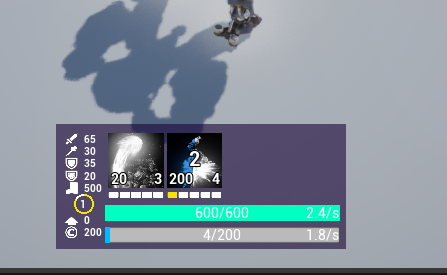
创建一个曲线表格
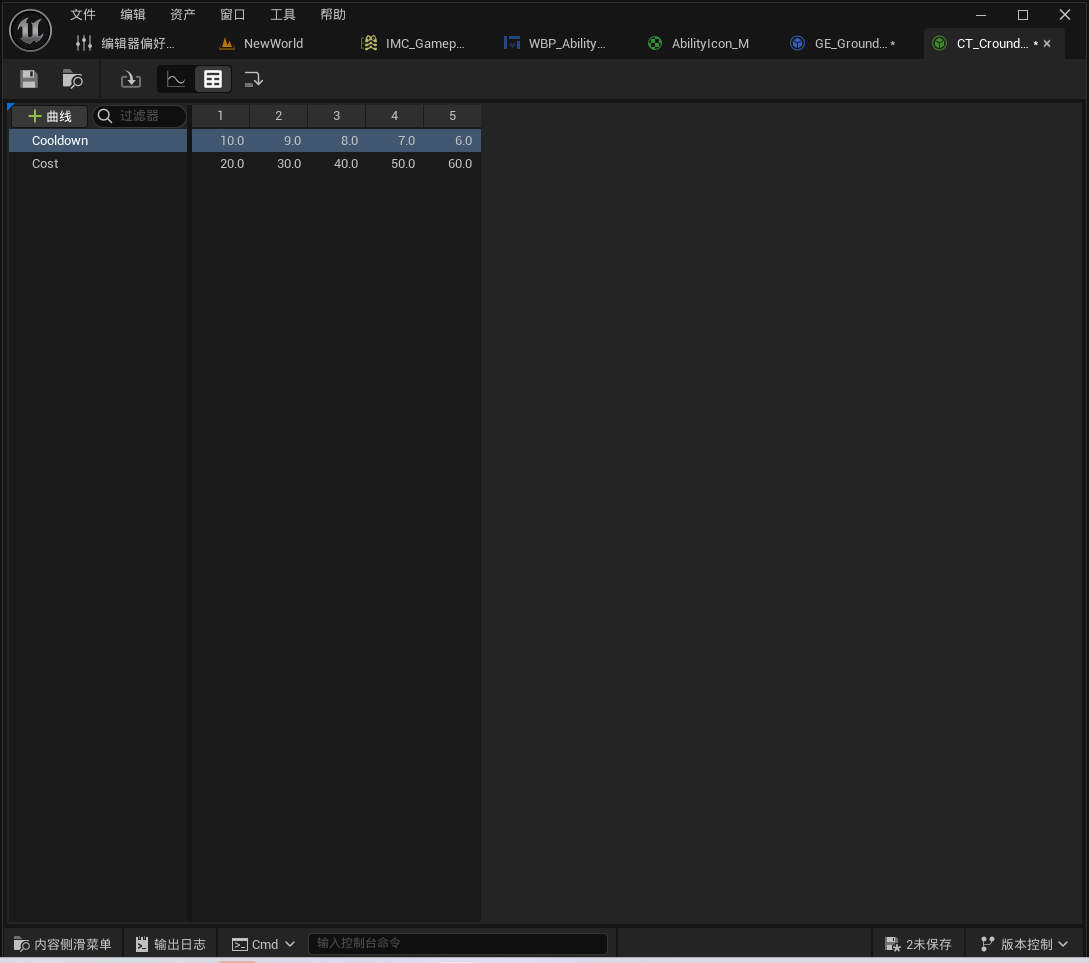
到GE中设置为可扩展浮点
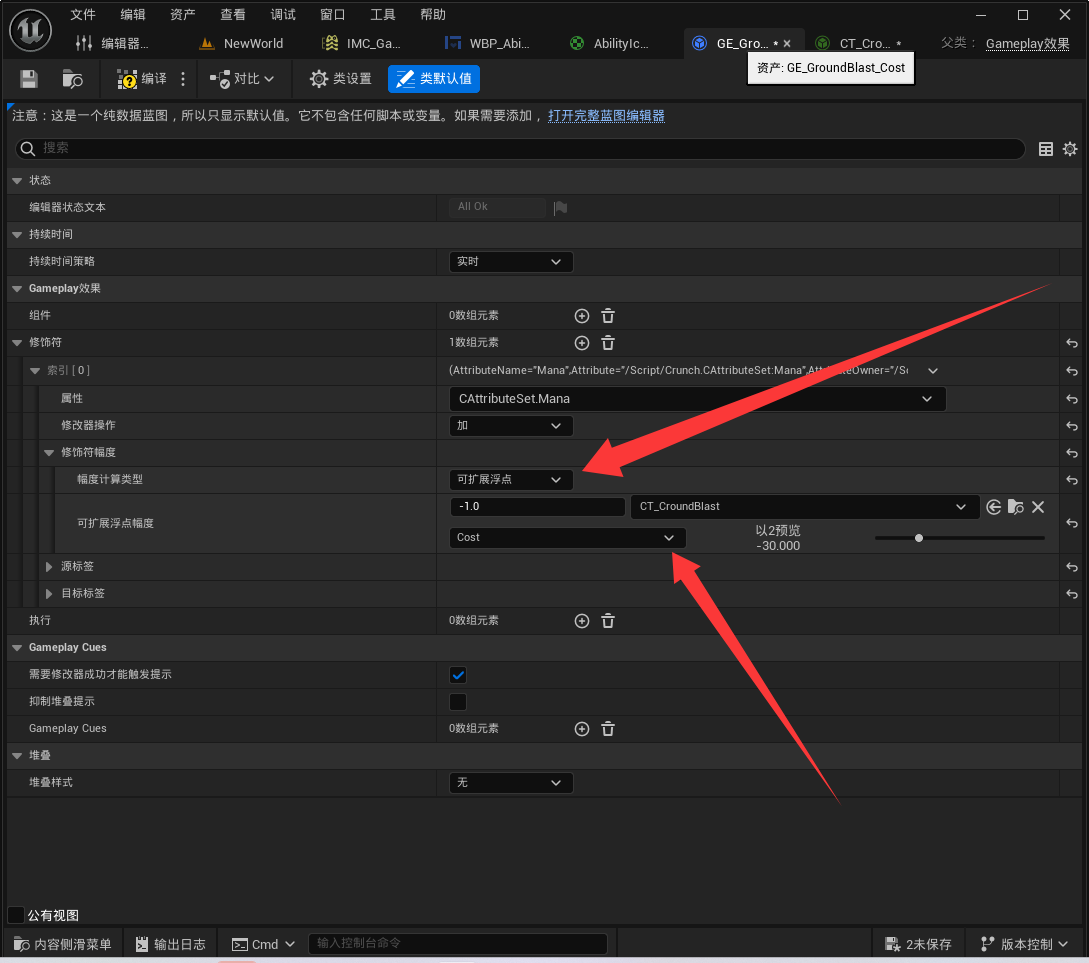
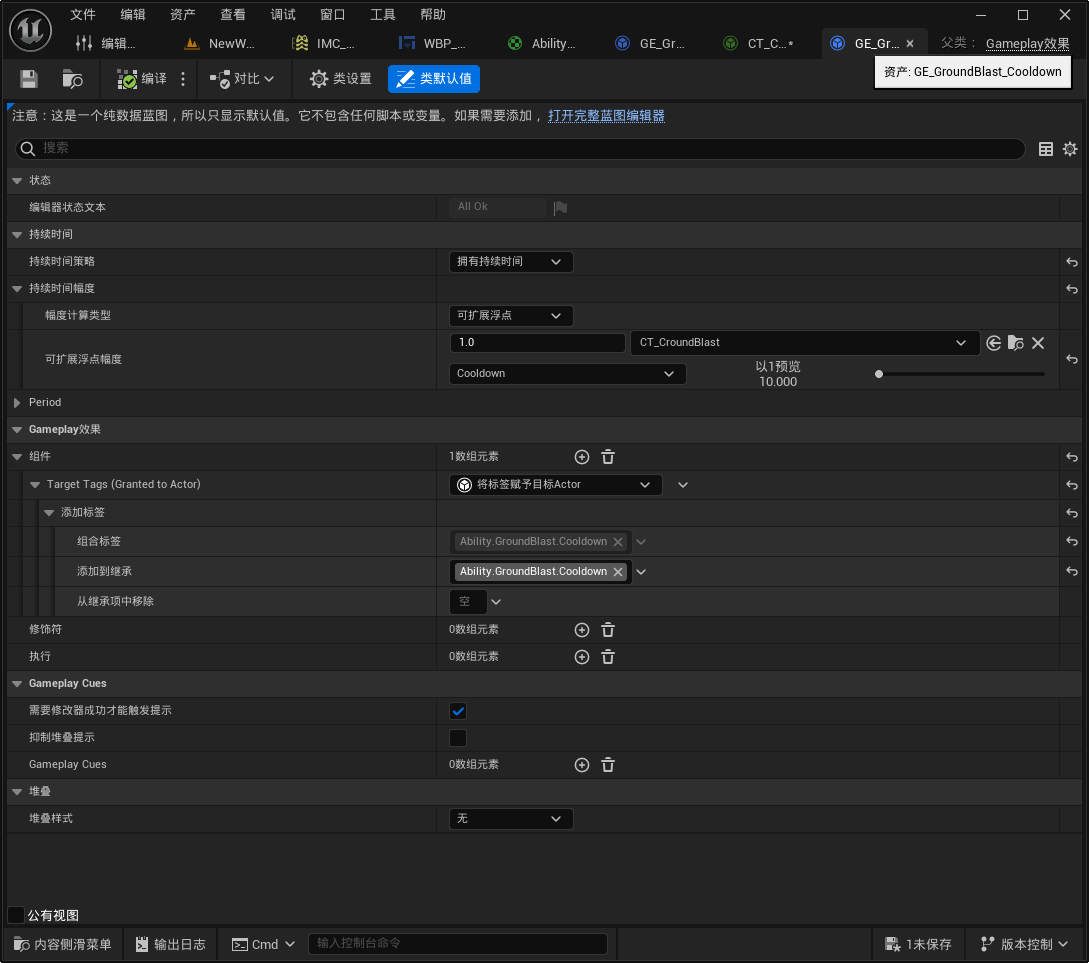
升级后应用上去了
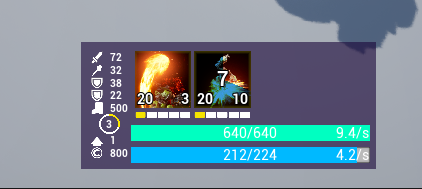
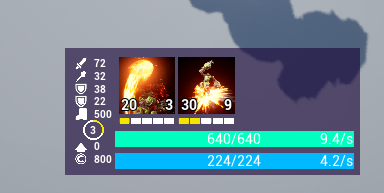
修改一下伤害的定义,让这个伤害也跟着一起升级
// 伤害效果定义
USTRUCT(BlueprintType)
struct FGenericDamageEffectDef
{
GENERATED_BODY()
public:
FGenericDamageEffectDef();
// 伤害类型
UPROPERTY(EditAnywhere)
TSubclassOf<UGameplayEffect> DamageEffect;
// 基础伤害大小
UPROPERTY(EditAnywhere)
FScalableFloat BaseDamage;
// 属性的百分比伤害加成
UPROPERTY(EditAnywhere)
TMap<FGameplayAttribute, float> DamageTypes;
// 力的大小
UPROPERTY(EditAnywhere)
FVector PushVelocity;
};
伤害的获取改为如此

void UCGameplayAbility::MakeDamage(const FGenericDamageEffectDef& Damage, int Level)
{
float NewDamage = Damage.BaseDamage.GetValueAtLevel(GetAbilityLevel());
//通过标签设置GE使用的配置
for(auto& Pair : Damage.DamageTypes)
{
bool bFound ;
float AttributeValue = GetAbilitySystemComponentFromActorInfo()->GetGameplayAttributeValue(Pair.Key, bFound);
if (bFound)
{
NewDamage += AttributeValue * Pair.Value / 100.f;
}
}
GetAbilitySystemComponentFromActorInfo()->SetNumericAttributeBase(UCAttributeSet::GetBaseDamageAttribute(), NewDamage);
}
添加一个伤害的值,随便设

然后GA中设置一下
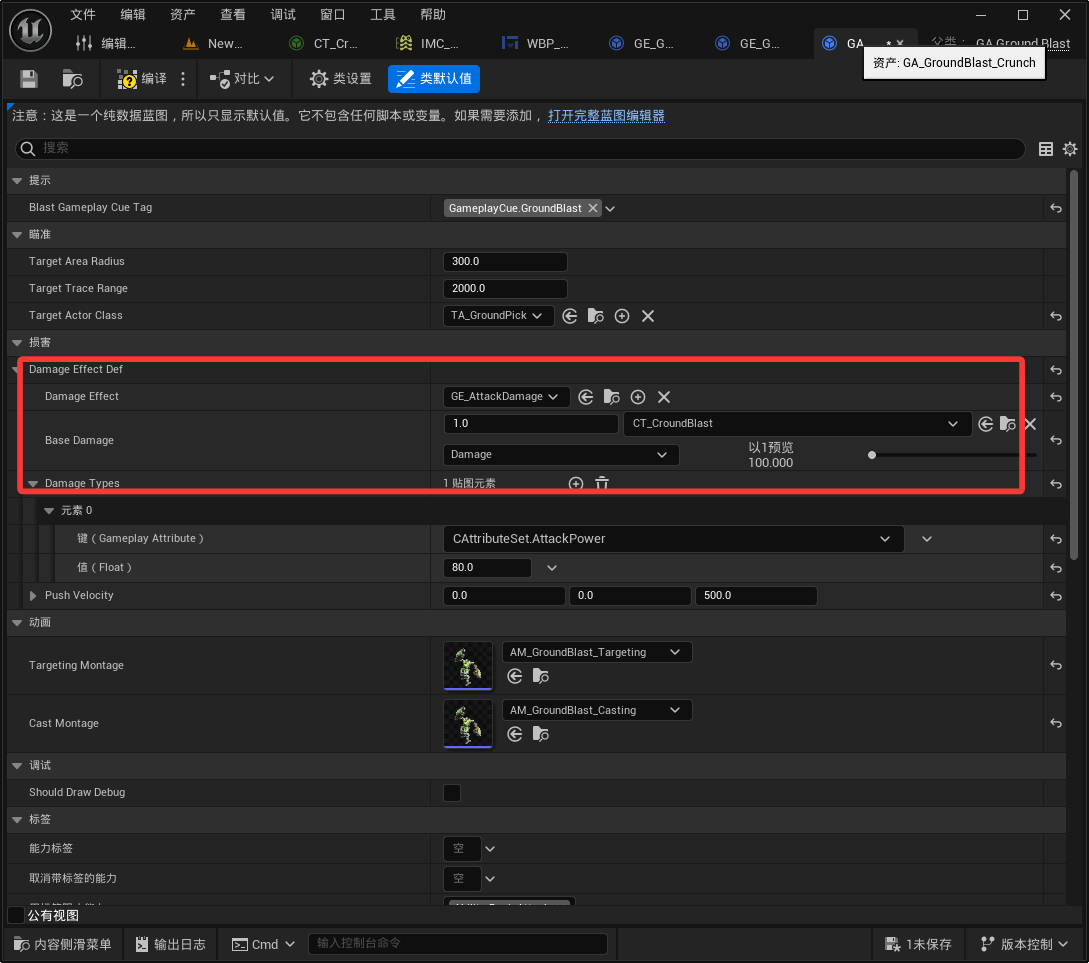
修复伤害数字特效只显示3位数的问题
发现特效的显示似乎有点问题,来到特效里面进行修改一下
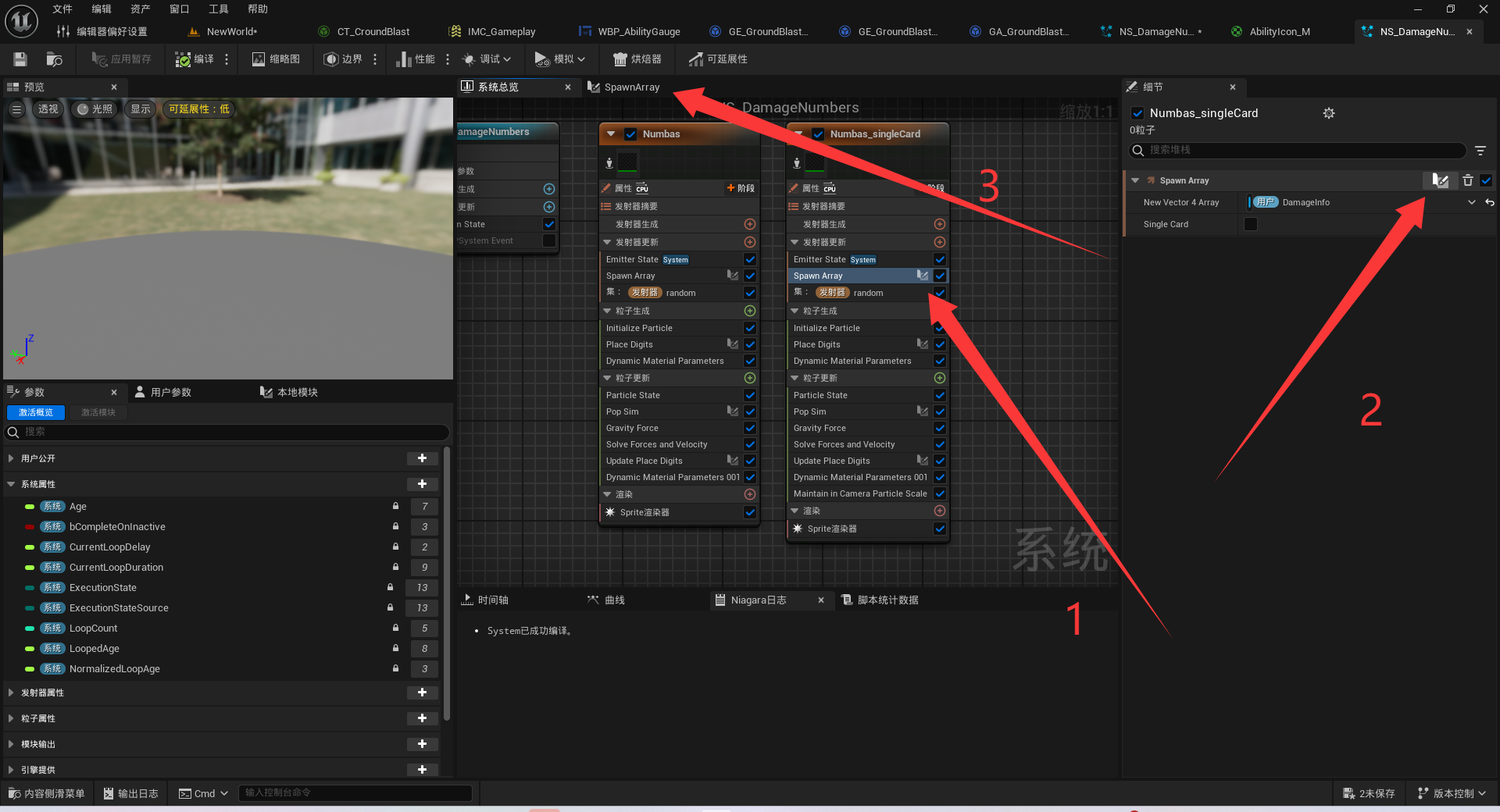
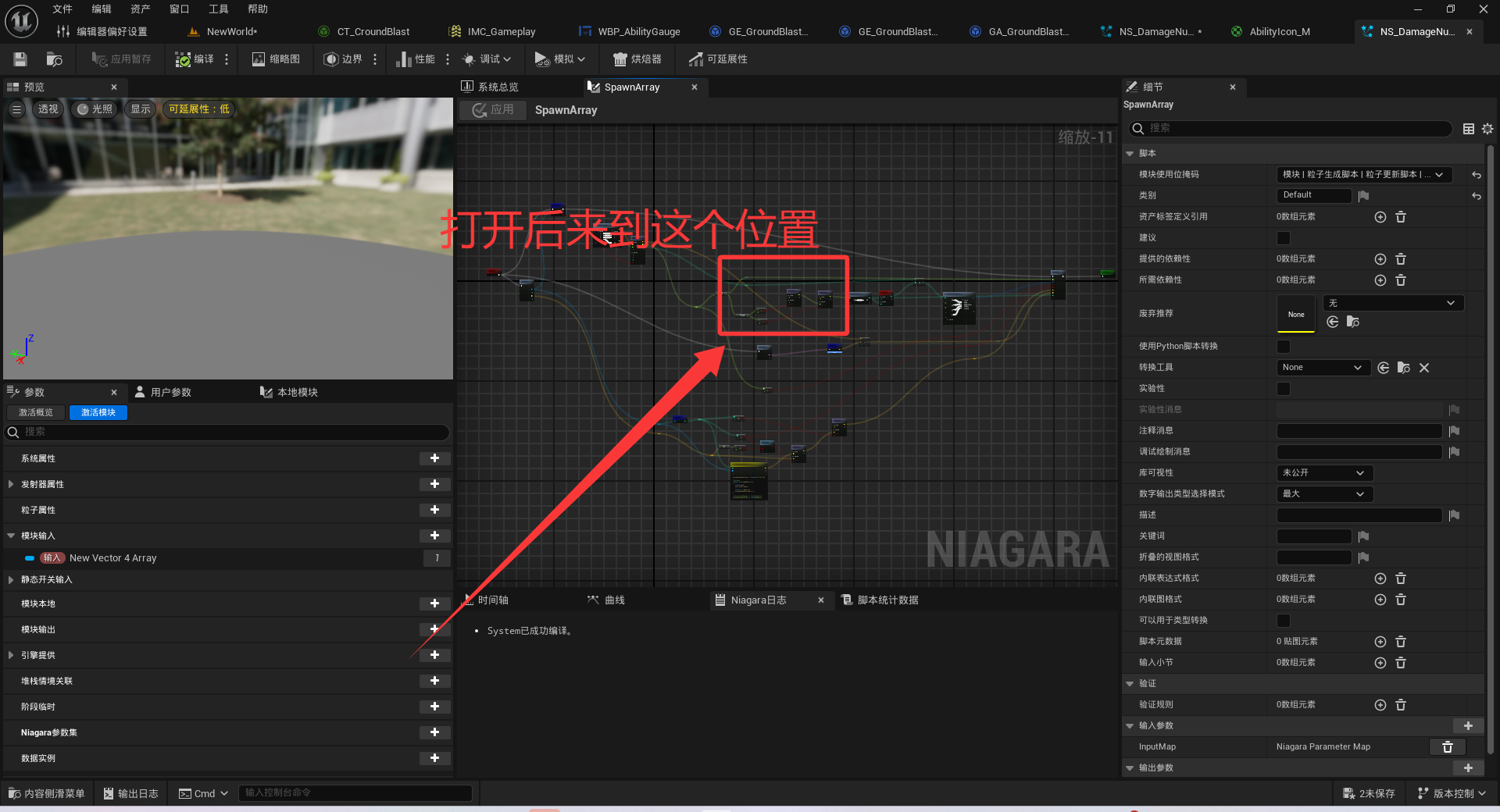
创建一个hlsl
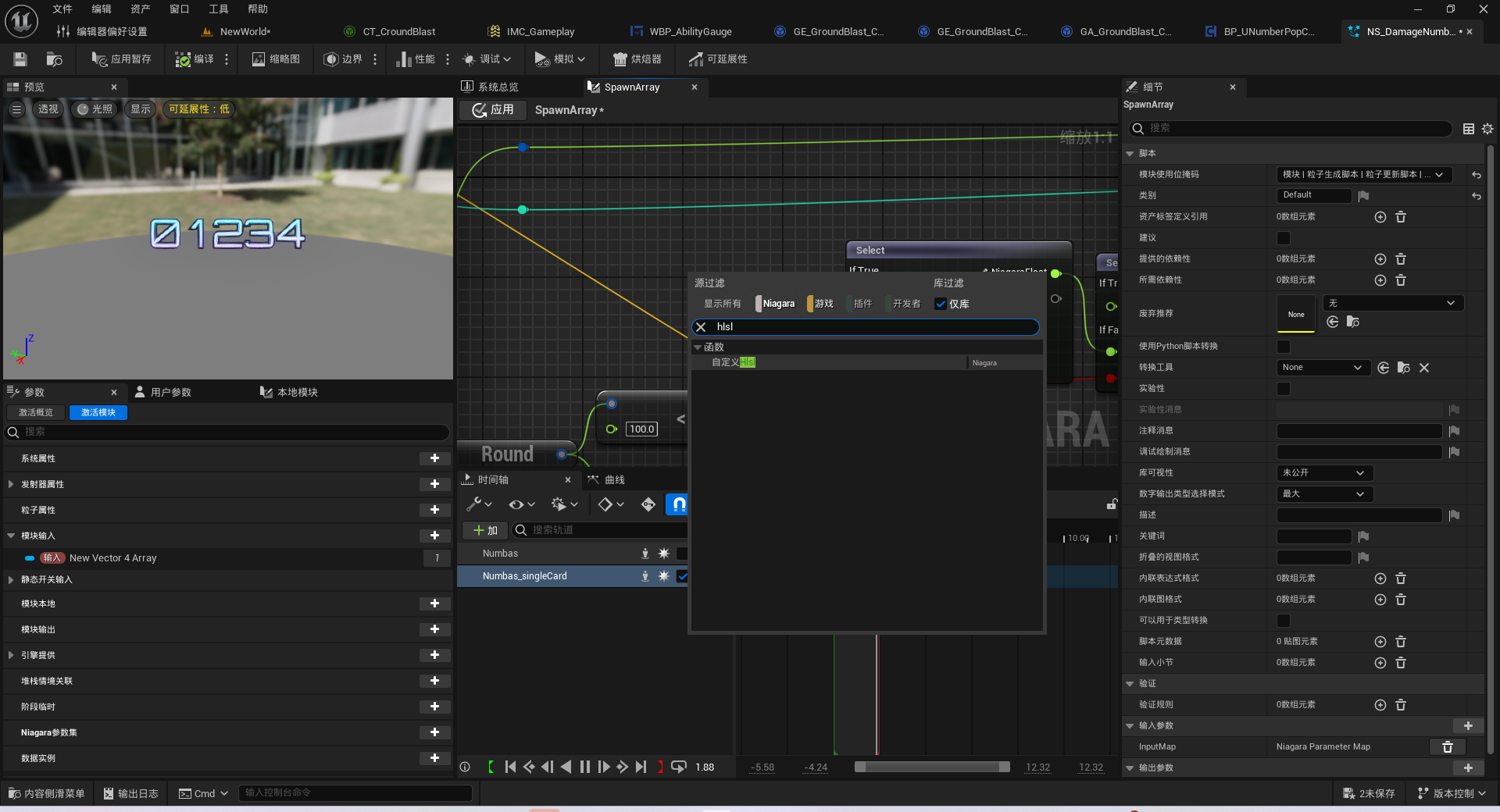
if (Result == 0) {
NiagaraFloat = 1;
} else {
float logVal = log10(abs(Result));
NiagaraFloat = floor(logVal) + 1;
}
把这几个删了
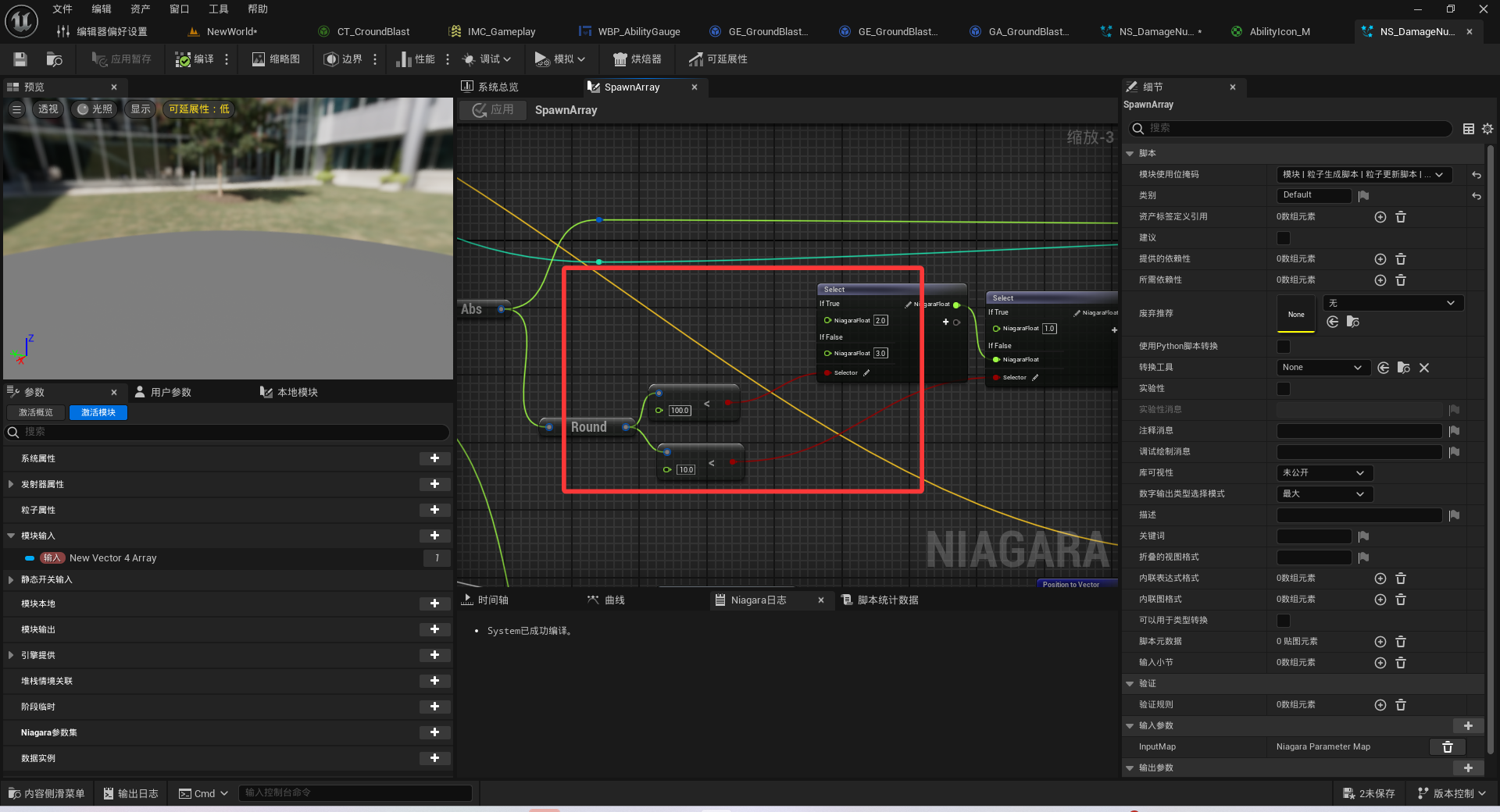
添加一下,由于伤害的显示这边数字太大的时候似乎显示并不正常,因此我就给他进行限制到99999
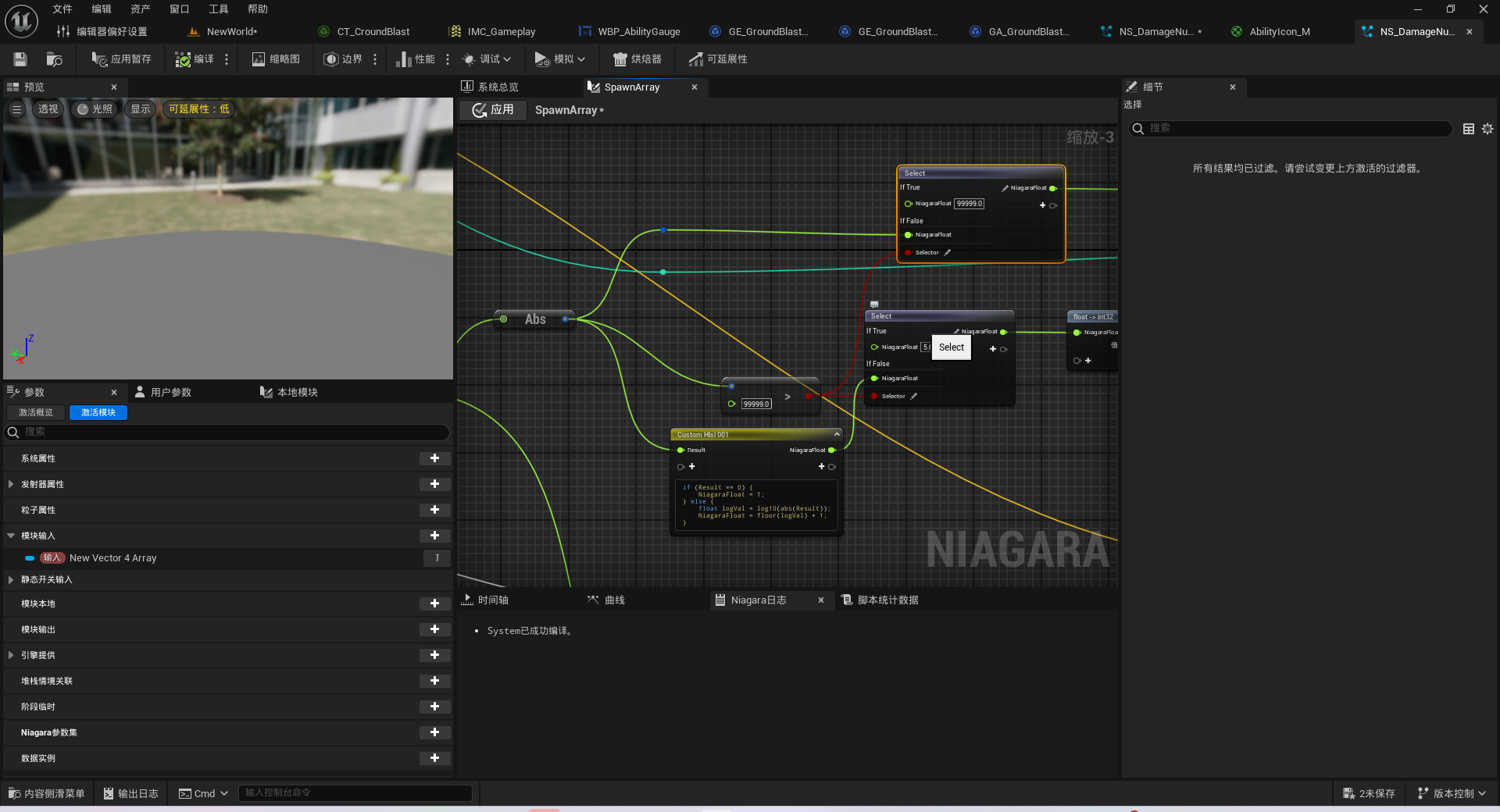
最后应用一下

这下就能显示更高的伤害了
